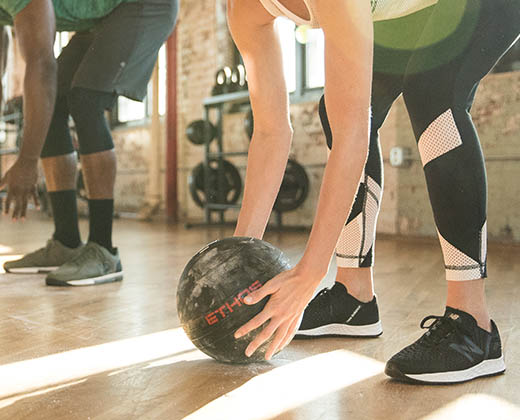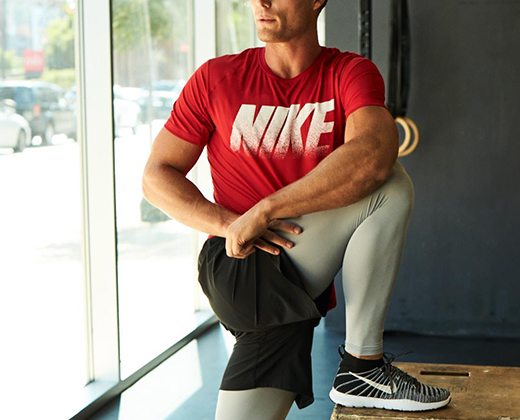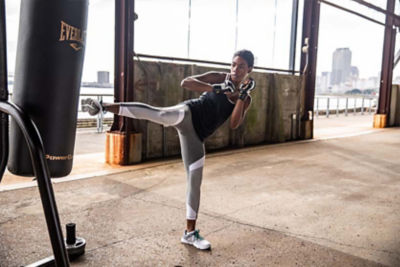No-Equipment Beach Workout
Skip the gym and tackle eight full-body exercises designed for the beach.
Whether you’re on vacation or you live near the ocean, taking your workout to the beach can be a nice change of pace. And, with the extra intensity and resistance that sand can add to a workout, it’s a welcome challenge, too.
A few tips before getting started: It’s best to work out early in the morning, before the sun is too high – and the beach is too crowded. Wear light-colored, sweat-wicking clothing and have water handy. Exercising barefoot is not recommended. Instead, choose a training shoe or a neutral running shoe to provide a layer of padding between your feet and the sand. There are even more ways to make the most of your beach workout.
THE WORKOUT
This is a circuit. Complete one round of all exercises, rest for 60 to 75 seconds, then repeat for a total of three to four sets.
Sprints: 1 X 20 – 40 meters
Sprints maximize aerobic capacity and help elevate your heart rate, which you can work to maintain through the rest of the workout.
Take off with energy and dig in as hard as you can. “The sand is going to provide some resistance, so make sure that you’re resisting back,” personal trainer Jaime Filer says.
Run in a straight line, with your knees tracking forward and your heels in, not splaying out. Pump your arms as much as you can and keep your chest up.
“This isn’t just a lower-body workout. Your arms help you get a little bit of wind and move faster,” Filer says.
Not only does running on sand up the resistance (compared to running on a sidewalk or treadmill), it also increases muscle engagement. You’ll activate your calf muscles far more on sand than you would on a treadmill, for example, Filer says.
BONUS PRO TIP: If the beach where you’re working out has buoys in the water, use them as a guide for distance. They’re typically spaced 50 to 100 meters apart. Sprint to one, then walk or jog back.
Jumping Jacks: 30 reps
Set up on a flat surface. Avoid the sloped part of the beach. As you hop, keep your chest up, fully extending from “X” to “I” shapes. Land lightly with soft knees. This is a light- to no-impact cardio workout, however, the sand adds a bit of resistance.
Lateral Squats: 20 reps (10 per side)
Because this is a quad- and knee-centric movement, Filer suggests setting up on a flat surface to help protect your joints.
Stand with feet hips-width apart. Chest up, shoulders back and down.
Take one lunge step forward and down, making sure your front knee does not extend past your toes. Your back knee can tap down or hover within an inch of the ground, depending on your mobility.
Push off your front foot to return to the starting position. Switch sides.
Lateral Shuffle: 20 to 40 meters in each direction
The most important element for this exercise? “Get low,” Filer says. “The lower you are to the ground, the more your leg muscles are engaged, the better the burn, the harder the workout.”
Start on a flat surface. Shuffle to the side with your chest up and your glutes engaged. Avoid hunching forward.
Walking Lunges: 20 reps (10 per side)
“These are an incredible exercise because they target every single muscle of the lower body,” Filer says.
This one is great for the beach, as you’ll have plenty of room to move. As you lunge, avoid letting your front knee extend past your toes. Press down into the ball of your front foot and engage the glutes of your back leg to lift up. You will lunge continuously, right foot then left foot.
Modification: Wedding March Lunges
Add a pause between lunges. Lunge forward with your right foot, then step your left foot up to meet it as you stand tall and stabilize. Lunge your left foot forward, step your right foot up.
Dynamic Planks: 20 seconds
“An exercise like the plank is incredible because it engages the obliques, the abs, the low back — everything,” Filer says.
Start in high plank, lowering to your right forearm, then left forearm. Press up through your right hand, then left hand. Lower your left forearm, then right. Press up through your left palm, then right. Continue to alternate. Press up through the meaty part of your palms and keep your legs and glutes tight.
Modification: Stationary Plank
Hold high plank or forearm plank for 20 seconds.
Bear Crawl: 20 to 40 meters
This full-body, low-impact cardio exercise is, in essence, walking on all fours. Filer recommends this as a low-impact alternative to running. Flex core and glutes to maintain a flat back and keep your knees soft. Pick up opposite feet and hands, taking little steps forward — avoid dragging your feet and hands.
“Your weight is totally dispersed over your upper body, centered in the middle, and you’re using the lower body as support to trail,” Filer says.
Modification: Stationary Bear Crawl
Stay in place and lift your opposite hand and foot as if you were crawling.
Burpees: 10 Reps
“To maintain proper form, tackle the burpee in its separate parts,” Filer says. “Even though a burpee lasts between one and three seconds, you constantly have to be thinking about your entire body and how it moves through that exercise.”
Movement number one is a squat. Engage your glutes and soften your shoulders.
Next, place your hands on the ground and set up for movement number two: a push-up. For proper form, lower your chest to the ground. If that’s not possible, drop your knees.
Step your feet to your hands and stand up, completing the third and final movement with a hop. Maintain a neutral neck with your gaze a few inches in front of you, not straining to look ahead or tucking your chin in.
Modification: Step Back, Step Forward
Step back to pause in stationary plank. Step forward. Stand tall and reach up.
Ready to take on this beach workout? Grab some waterproof sunscreen, a hat and get ready to sweat.








